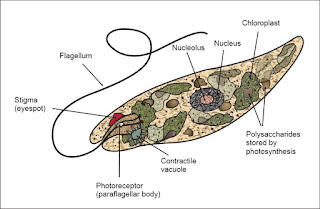Study of Paramecium | General characters and classification
Study of Paramecium with General characters and classification
Defination- Paramecium is a single-celled organism.This ranges in size from 50 to 300um, and varies from species to species. It is found mostly in freshwater environments.
It is a single-celled eukaryote belonging to the Protista group, and is a well-known protozoan ciliate genus.
1.Shape and Size-
P. cadatum is a onecelled, microscopic protozoan. Its dimensions range from 170 to 290um or from 300 to 350um. Surprisingly, paramecium is visible to the naked eye and has a shape-like elongated slipper, which is why it is also called a slipper animal.
2. Organelles and their functions-
a) Pellicle-
Its whole body is covered with a flexible, thin and firm membrane called pellicles. These pellicles are elastic in nature which supports the cell membrane. It is made up of a gelatinous substance.
b) Cilia -
Cilia refers to the multiple, small hair-like projections that cover the whole body. It is arranged in longitudinal rows with a uniform length throughout the body of the animal. This condition is called holotrichous. There are also a few longer cilia present at the posterior end of the body forming a caudal tuft of cilia, thus named caudatum.
The structure of cilia is the same as flagella, a sheath made of protoplast or plasma membrane with longitudinal nine fibrils in the form of a ring. The outer fibrils are much thicker than the inner ones with each cilium arising from a basal granule. Cilia have a diameter of 0.2um and helps in its locomotion.
c) Cytostome-
cytostome contains six parts which are as follows-
1.Oral groove: There is a large oblique shallow depression on the ventrio-lateral side of the body called peristome or an oral grove. This oral groove gives an asymmetrical appearance to the animal. It further extends into a depression called a vestibule through a short conical funnel. This vestibule further extends into the cytostome through an oval-shaped opening, through a long opening called a cytopharynx and then the esophagus leads to the food vacuole.
2.Cytopyge: Lying on the ventral surface, just behind the cytostome is the cytopyge also called a cytoproct. All the undigested food gets eliminated through the cytopyge.
3.Cytoplasm: Cytoplasm is a jelly-like substance further differentiated into the ectoplasm. The ectoplasm is a narrow peripheral layer. It is a dense and clear layer with an inner mass of endoplasm or semifluid plasmasol that is granular in shape.
4.Ectoplasm: Ectoplasm forms a thin, dense and clear outer layer containing cilia, trichocysts, and fibrillar structures. This ectoplasm is further bound to pellicle externally through a covering.
5.Endoplasm: Endoplasm is one of the most detailed parts of the cytoplasm. It contains several different granules. It contains different inclusions and structures like vacuoles, mitochondria, nuclei, food vacuole, contractile vacuole etc.
6.Trichocysts: Embedded in the cytoplasm are small spindle-like bodies called trichocysts. Trichocysts are filled with a dense refractive fluid containing swelled substances. There is a conical head on the spike at the outer end. Trichocysts are perpendicular to the ectoplasm.
d) Nucleus-
Paramecium contains two nucleus -
i. Macro nucleus
ii. Micro nucleus
Macro-Nucleus: Macronucleus is kidney like or ellipsoidal in shape. It's densely packed within the DNA (chromatin granules). The macronucleus controls all the vegetative functions of paramecium hence called the vegetative nucleus.
Micro- Nucleus: The micronucleus is found close to the macronucleus. It is a small and compact structure, spherical in shape. The fine chromatin threads and granules are uniformly distributed throughout the cell and control reproduction of the cell. The number in a cell varies from species to species. There is no nucleolus present in caudatum.
e) Contractile vaculoe-
There are two contractile vacuoles present close to the dorsal side, one on each end of the body. They are filled with fluids and are present at fixed positions between the endoplasm and ectoplasm. They disappear periodically and hence are called temporary organs. Each contractile vacuole is connected to at least five to twelve radical canals. These radical canals consist of a long ampulla, a terminal part and an injector canal which is short in size and opens directly into the contractile vacuole. These canals pour all the liquid collected from the whole body of paramecium into the contractile vacuole which makes the vacuole increase in size. This liquid is discharged to the outside through a permanent pore.
f) Food vaculoe-
Food vacuole is non-contractile and is roughly spherical in shape. In the endoplasm, the size of food vacuole varies and digest food particles, enzymes alongside a small amount of fluid and bacteria. These food vacuoles are associated with the digestive granules that aid in food digestion.
General Characters of Parmecium caudatum-
1.Occurrence: It is found in freshwater ponds, pools, ditches, streams,rivers, lakes, etc. It is abundantly found in stagnant water, where decaying organic matter is in plenty.
2.Locomotion: It moves here and there with the help of cilia, which also functions as food capture.
3.Nutrition: It ingests bacteria and other microscopic organisms or minute protozoans. So nutrition is holozoic.
4.Digestion: intracellular.
5.Respiration and excretion: takes place by general body surfacethrough diffusion process.In paramecium, excretion is also done contractile vacuole and cytoproct.6.Reproduction: Asexually by transversebinary fission and sexually by conjugation.
Classification-
Phylum: Protozoa
Sub Phylum: Ciliophora
Class: Ciliatea
Order: Hymenostomatida
Genus: Paramecium
Species: caudatum




Comments
Post a Comment